The music industry stands at a pivotal moment where technological innovation meets artistic expression, fundamentally reshaping how creators monetize their work and connect with audiences. Non-fungible tokens have emerged as a revolutionary force that promises to restore power to artists by enabling direct ownership and control over their digital creative assets. This transformation represents more than just a new revenue stream; it embodies a paradigm shift that could permanently alter the relationship between artists, intermediaries, and fans in the digital music ecosystem.
The Traditional Music Industry’s Control Problem
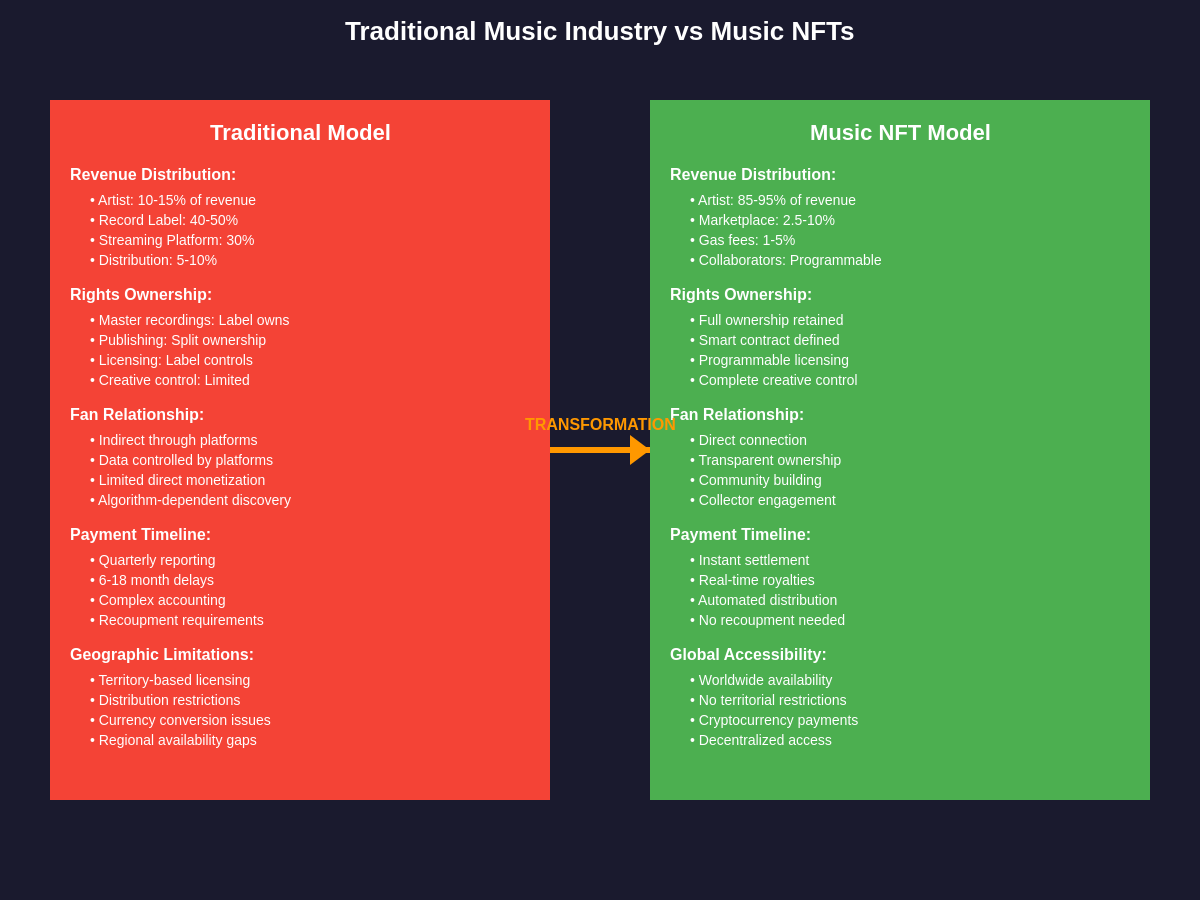
For decades, the music industry has operated under a system where artists surrender significant control over their creative works in exchange for distribution, marketing, and financial support from record labels and streaming platforms. This traditional model has created numerous inefficiencies and inequities that have long frustrated independent artists and established musicians alike. Record labels typically retain ownership of master recordings, leaving artists with limited rights to their own creative output and minimal control over how their music is distributed, marketed, or monetized.
The rise of streaming platforms promised to democratize music distribution, but instead created new forms of centralized control where platforms like Spotify, Apple Music, and YouTube Music dictate royalty rates, algorithm preferences, and discovery mechanisms. Artists receive fractions of pennies per stream, with the majority of revenue flowing to platform operators and record labels rather than the creators themselves. This system has particularly disadvantaged emerging artists who lack the resources to navigate complex licensing agreements and promotional requirements necessary for meaningful exposure.
Digital rights management in the traditional system remains opaque and inefficient, with artists often unaware of how their music is being used across different platforms and territories. The complexity of music rights, including mechanical rights, performance rights, synchronization rights, and master recording rights, creates a labyrinthine system that benefits intermediaries more than creators. Artists frequently discover their music being used in contexts they never approved, with little recourse for enforcement or fair compensation.
Understanding Music NFTs and Blockchain Technology
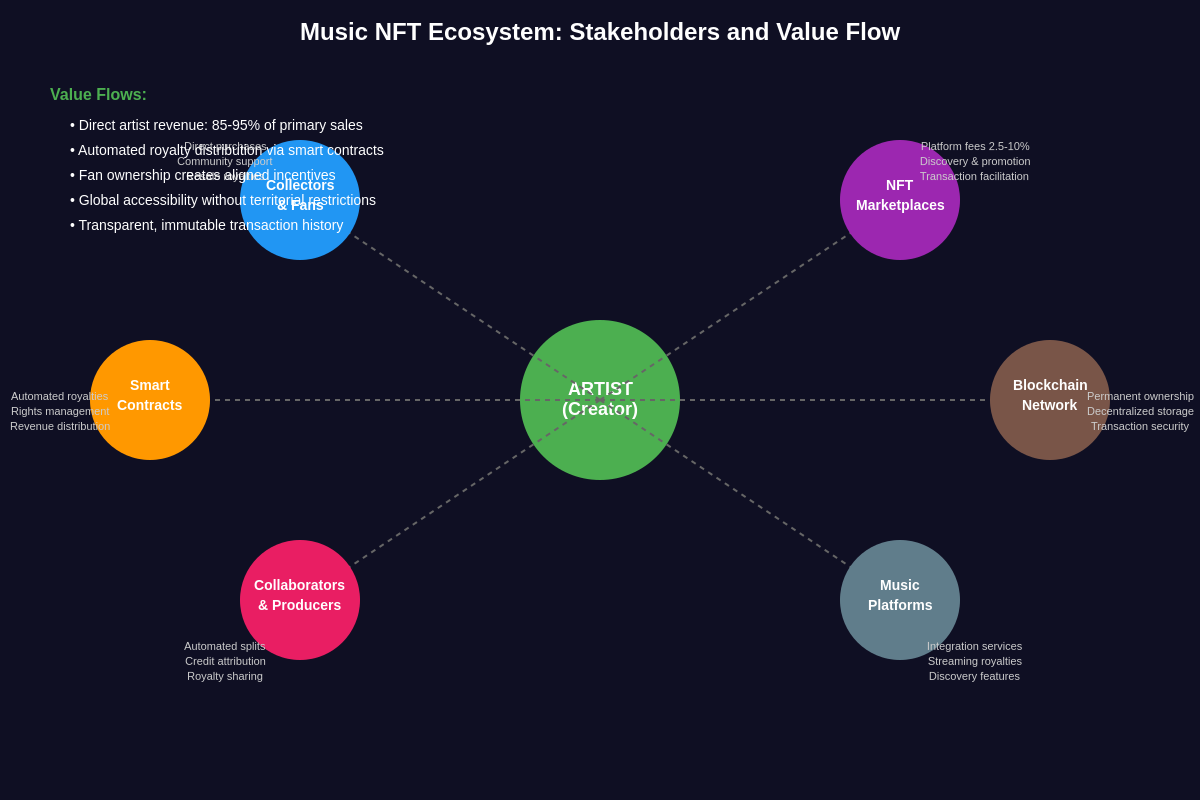
Music NFTs represent a fundamental reimagining of how digital music assets can be created, owned, and traded using blockchain technology. Unlike traditional digital files that can be endlessly copied without attribution or compensation, NFTs create unique, verifiable digital certificates of ownership that are permanently recorded on decentralized blockchain networks. When artists mint their music as NFTs, they create scarce digital assets that can be owned, collected, and traded while maintaining provable connection to the original creator.
The underlying blockchain technology ensures that each music NFT contains immutable metadata that can include not only the audio file but also detailed rights information, royalty structures, and licensing terms. Smart contracts embedded within these NFTs can automatically execute royalty payments, licensing agreements, and usage restrictions without requiring intermediaries or manual oversight. This technological foundation enables artists to program their preferred business terms directly into their digital assets, creating self-executing agreements that honor creator intentions.
Music NFTs can take various forms, from complete songs and albums to individual stems, loops, and samples that producers can incorporate into new compositions. Some artists create visual art components that accompany their music NFTs, while others include exclusive experiences like private concert access, merchandise, or direct communication with the artist. The flexibility of NFT smart contracts allows creators to design unique value propositions that extend far beyond traditional music sales or streaming models.
The decentralized nature of blockchain networks means that music NFTs exist independently of any single platform or corporation, giving artists true ownership of their digital assets. While NFT marketplaces facilitate discovery and trading, the underlying assets remain under artist control, eliminating the risk of platform deactivation or policy changes that could eliminate years of creative work. This represents a significant departure from centralized platforms where artists build audiences and catalogs that could disappear at the discretion of platform operators.
Direct Artist-to-Fan Relationships Through NFTs
Music NFTs fundamentally transform the relationship between artists and their audiences by eliminating intermediaries and enabling direct economic connections. When fans purchase music NFTs, they engage in direct financial transactions with artists, creating more sustainable revenue streams that don’t depend on streaming platform algorithms or record label promotion budgets. This direct relationship allows artists to capture the full value of their creative work while building deeper connections with supporters who invest in their success.
The collectible nature of music NFTs creates new forms of fan engagement where supporters become stakeholders in an artist’s career trajectory. Fans who own early NFTs from emerging artists can benefit financially as those artists gain popularity and their NFTs appreciate in value. This dynamic aligns fan interests with artist success in ways that traditional music consumption never achieved, creating communities of supporters who actively promote and invest in their favorite creators.
Artists can leverage music NFTs to offer exclusive experiences and content that strengthen fan relationships beyond simple music consumption. NFT holders might receive access to private discord channels, exclusive live performances, behind-the-scenes content, or early access to new releases. Some artists create tiered NFT collections where different ownership levels unlock different benefits, creating sustainable community-building mechanisms that generate ongoing engagement rather than one-time purchases.
The transparency of blockchain transactions allows artists to identify and reward their most dedicated supporters with airdrops, special editions, or personalized experiences. This level of fan insight was previously available only to major labels with sophisticated data analytics capabilities, but NFTs democratize access to fan behavior data while respecting privacy through pseudonymous blockchain addresses. Artists can build direct marketing lists, understand purchasing patterns, and reward loyalty without relying on social media platforms or streaming services that control fan data.
Royalty Revolution and Smart Contract Automation
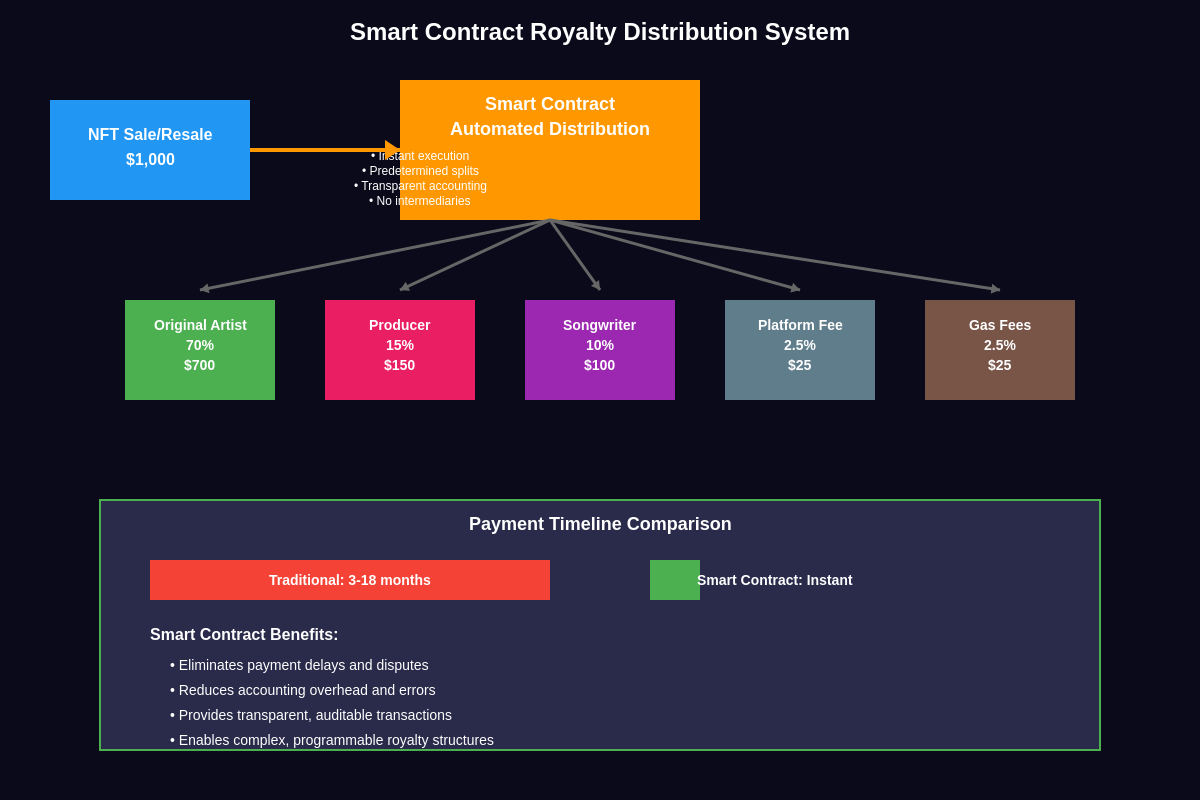
Smart contracts embedded in music NFTs revolutionize royalty distribution by automating payments and eliminating the delays and inefficiencies inherent in traditional music industry accounting. When music NFTs generate revenue through resales, licensing deals, or streaming integration, smart contracts can instantly distribute predetermined percentages to artists, collaborators, producers, and other stakeholders according to pre-programmed agreements. This automation eliminates the need for complex royalty collection societies and reduces the potential for disputes or delayed payments.
The programmable nature of smart contracts allows artists to create sophisticated royalty structures that reflect the true complexity of music creation and collaboration. A single music NFT can automatically distribute revenue among songwriters, performers, producers, engineers, and featured artists according to their agreed-upon contributions. Traditional music industry accounting often requires months or years to calculate and distribute royalties, while smart contracts execute these payments within minutes of revenue generation.
Artists can program escalating royalty rates that increase based on the success of their music NFTs, creating performance-based compensation structures that reward viral or commercially successful releases. Smart contracts can also include charitable donations, fan rewards, or reinvestment funds that automatically allocate portions of revenue toward specified purposes. This level of financial programmability gives artists unprecedented control over how their music generates and distributes wealth across their creative ecosystems.
The transparency of blockchain-based royalty distribution means that all stakeholders can verify payments and revenue flows in real-time, eliminating the opacity that has long plagued traditional music industry accounting. Musicians can track exactly how much revenue their work generates, when payments are distributed, and how their music is being monetized across different contexts. This transparency builds trust among collaborators and enables more equitable profit-sharing arrangements that reflect actual contribution rather than negotiating power.
Breaking Free from Streaming Platform Limitations
Music NFTs offer artists liberation from the restrictive economics and algorithmic control of traditional streaming platforms where success depends heavily on playlist placement and recommendation engine preferences. While streaming platforms pay artists between $0.003 and $0.005 per stream, music NFTs can generate anywhere from tens of dollars to thousands of dollars per purchase, dramatically improving the economics of music creation for artists with dedicated fan bases. This economic efficiency means that artists need significantly fewer supporters to achieve financial sustainability compared to streaming-dependent models.
The algorithmic nature of streaming platform discovery creates winner-take-all dynamics where a small percentage of artists receive the majority of platform promotion and revenue. Music NFTs operate in open marketplaces where discovery depends on community engagement, collector interest, and artistic quality rather than opaque algorithmic preferences. Artists can build sustainable careers by cultivating collector communities that appreciate and invest in their creative development over time.
Streaming platforms maintain extensive control over content policies, revenue sharing terms, and feature availability that can change at any time without artist input. Musicians who build careers on platforms like Spotify or Apple Music remain vulnerable to policy changes, account suspensions, or platform failures that could eliminate their primary income sources. Music NFTs exist independently on decentralized blockchain networks, ensuring that artists maintain permanent control over their digital assets regardless of marketplace or platform changes.
The global nature of blockchain networks means that music NFTs can be bought, sold, and enjoyed by fans worldwide without the territorial licensing restrictions that complicate traditional music distribution. Artists no longer need to negotiate separate distribution deals for different countries or worry about geographic availability limitations that prevent international fans from supporting their work. Professional traders often monitor global cryptocurrency market movements to understand how market conditions affect NFT valuations and artist revenue potential.
Innovative Revenue Models and Fan Engagement
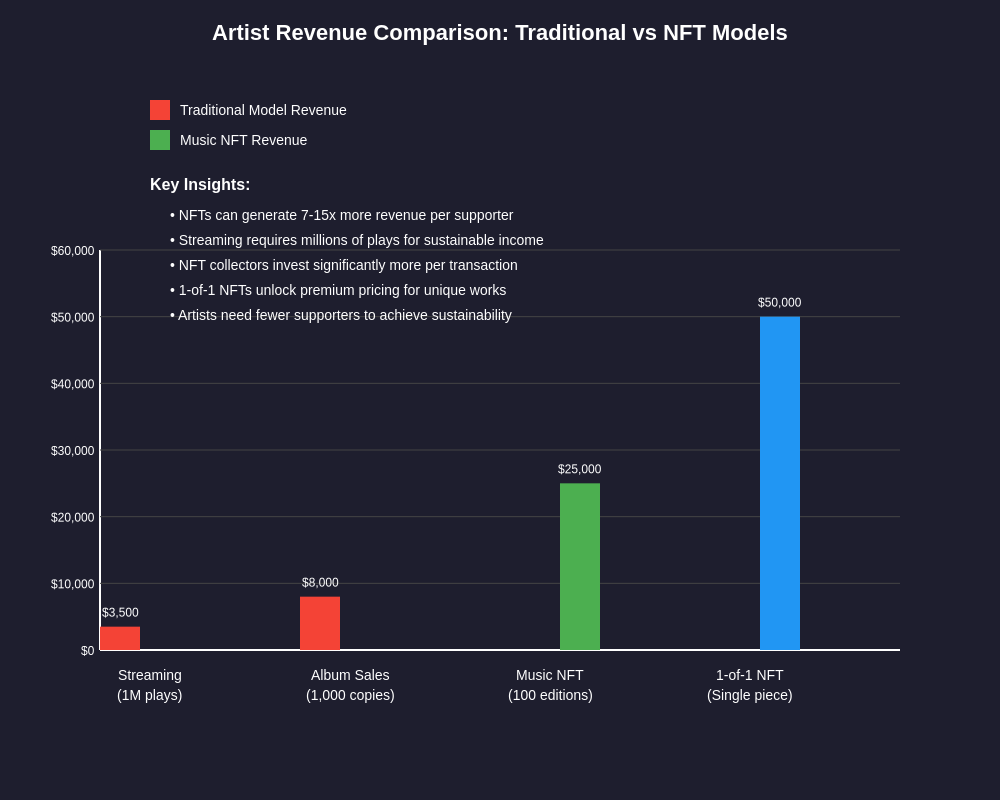
Music NFTs enable artists to experiment with creative revenue models that extend far beyond traditional sales and streaming income. Artists can create limited edition releases that generate scarcity value, auction one-of-a-kind recordings to collectors, or offer fractional ownership of master recordings that allow fans to invest directly in music catalog value. These diverse monetization approaches allow artists to match their revenue strategies to their creative output and fan base characteristics.
Some artists use music NFTs to crowdfund new projects by selling pre-release NFTs that include exclusive content, credits, or profit-sharing arrangements. This approach allows creators to finance recording, production, and marketing costs without surrendering ownership to record labels or investors. Fans who support these campaigns become stakeholders in the project’s success, creating aligned incentives that encourage promotion and long-term engagement with the artist’s career.
The programmable nature of NFT smart contracts enables artists to create dynamic pricing models that respond to demand, time, or other variables. Artists might release NFTs with declining prices over time, auction formats that reward early supporters, or bundled packages that include multiple releases or experiences. Some creators implement loyalty programs where long-term collectors receive discounts, exclusive access, or bonus content that rewards sustained support.
Collaboration between artists becomes more efficient and transparent through music NFTs that can automatically split revenue among multiple creators according to predetermined agreements. Musicians can easily collaborate across geographic boundaries, contribute to collective projects, or participate in compilation albums where each contributor maintains ownership of their individual work while participating in shared promotional efforts. Sophisticated investors utilize advanced charting and analysis tools to evaluate music NFT projects and assess their long-term value potential in the evolving digital collectibles market.
Challenges and Considerations in Music NFT Adoption
Despite their revolutionary potential, music NFTs face significant challenges that artists must carefully consider before fully embracing this new model. The environmental concerns associated with certain blockchain networks have created controversy around NFTs, though the development of more energy-efficient blockchain solutions like Ethereum 2.0 and alternative networks like Polygon and Solana are addressing these sustainability issues. Artists must weigh environmental considerations against the potential benefits of decentralized ownership and control.
The technical complexity of creating, minting, and managing music NFTs can be overwhelming for artists who lack blockchain expertise or technical support. Understanding wallet management, gas fees, smart contract deployment, and marketplace navigation requires significant learning investment that may deter artists from adopting these technologies. The user experience for both creators and collectors continues to improve, but remains more complex than traditional music distribution platforms.
Market volatility in cryptocurrency and NFT spaces creates uncertainty around revenue projections and long-term value storage. Artists who depend on music NFT sales for income must navigate fluctuating cryptocurrency values, changing collector preferences, and evolving marketplace dynamics that can significantly impact earnings. The speculative nature of some NFT markets may not align with artists seeking stable, predictable income streams from their creative work.
Legal and regulatory uncertainty around NFTs, copyright law, and digital asset taxation creates compliance challenges for artists operating in this space. Different jurisdictions have varying approaches to NFT regulation, and the evolving legal landscape means that artists must stay informed about potential legal obligations, tax implications, and rights management requirements. The intersection of traditional copyright law with blockchain-based ownership creates complex scenarios that may require legal expertise to navigate properly.
Building Sustainable Music NFT Communities
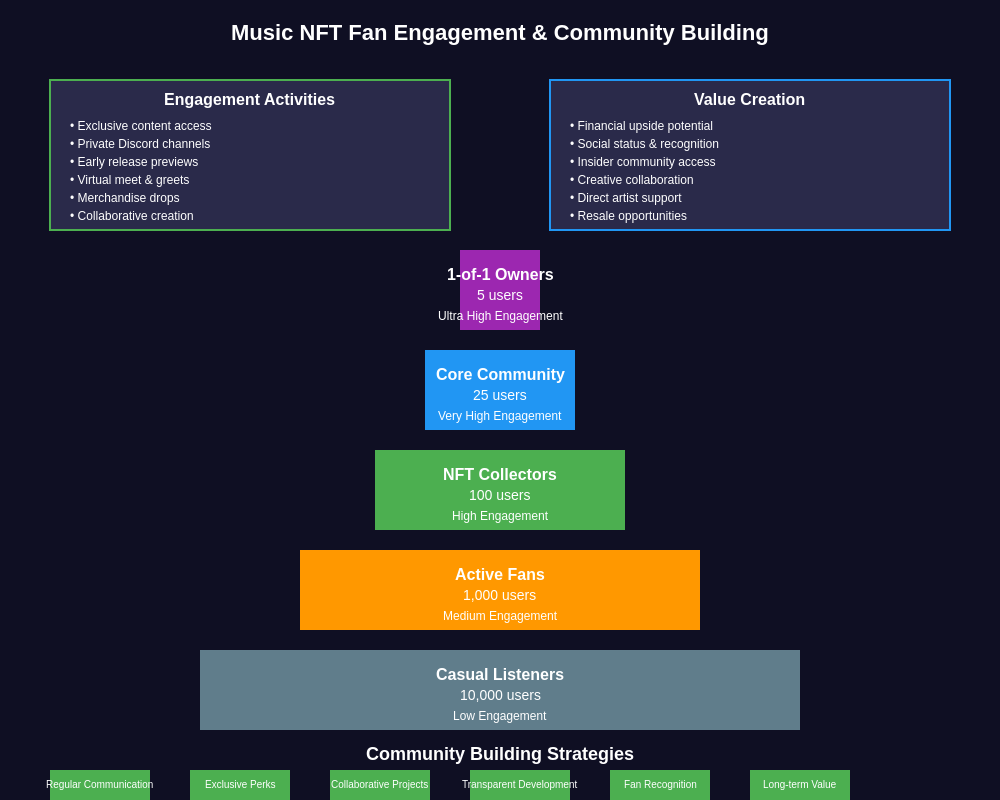
Successful music NFT adoption requires artists to think beyond individual sales and focus on building sustainable communities of collectors and supporters who engage with their work over time. This community-building approach involves regular communication with collectors, exclusive content creation, and ongoing value delivery that justifies long-term investment in an artist’s NFT ecosystem. Artists who treat their NFT holders as stakeholders rather than customers often achieve better long-term success.
Educational content and transparent communication help artists build trust with potential collectors who may be unfamiliar with NFT technology or blockchain concepts. Artists who take time to explain their NFT strategies, share their creative processes, and educate their audiences about blockchain technology often develop more engaged and supportive collector communities. This educational approach also helps legitimize music NFTs among traditional music fans who may be skeptical of new technologies.
Collaboration with other artists, collectors, and NFT platforms can amplify promotional efforts and introduce artists to new audiences within the broader NFT ecosystem. Cross-promotional activities, collaborative releases, and participation in NFT community events help artists build recognition and credibility within collector communities. Some artists organize virtual galleries, listening parties, or educational events that bring together collectors and creators for mutual benefit.
The long-term success of music NFTs depends on artists delivering consistent value to their collector communities through exclusive content, experiences, and ongoing engagement. Artists who disappear after initial NFT sales or fail to maintain communication with their communities often struggle to build sustainable NFT-based careers. Successful music NFT artists treat their collector relationships as ongoing partnerships that require nurturing and attention over time.
Integration with Traditional Music Industry Structures
Rather than completely replacing traditional music industry structures, many artists are finding ways to integrate music NFTs with existing distribution, promotional, and licensing systems. This hybrid approach allows artists to maintain access to traditional revenue streams while experimenting with NFT-based monetization and fan engagement. Artists can release music through traditional channels while offering exclusive NFT content, behind-the-scenes access, or collector-only experiences that complement their mainstream releases.
Record labels and music industry organizations are beginning to explore NFT integration as a complement to their existing services rather than a replacement. Some labels offer NFT creation and marketing services to their artists, while others experiment with NFT-based fan engagement tools that enhance traditional promotional campaigns. This integration approach helps bridge the gap between traditional music industry practices and blockchain-based innovation.
Music licensing and synchronization opportunities for NFT-based music are evolving as brands, media companies, and content creators explore ways to incorporate NFT music into their projects. The clear ownership and rights information embedded in music NFTs can simplify licensing negotiations and ensure that artists receive appropriate compensation for commercial use of their work. Some artists specifically create NFT music designed for licensing applications, creating new revenue streams that complement their collector-focused releases.
The development of blockchain-based music distribution platforms that integrate with traditional streaming services represents another bridge between old and new industry models. These platforms allow artists to maintain NFT ownership and control while ensuring their music remains accessible through popular streaming services. Market participants tracking NFT sector performance and digital asset trends can better understand how traditional music industry integration affects overall market valuations and adoption rates.
Technology Infrastructure and Platform Development
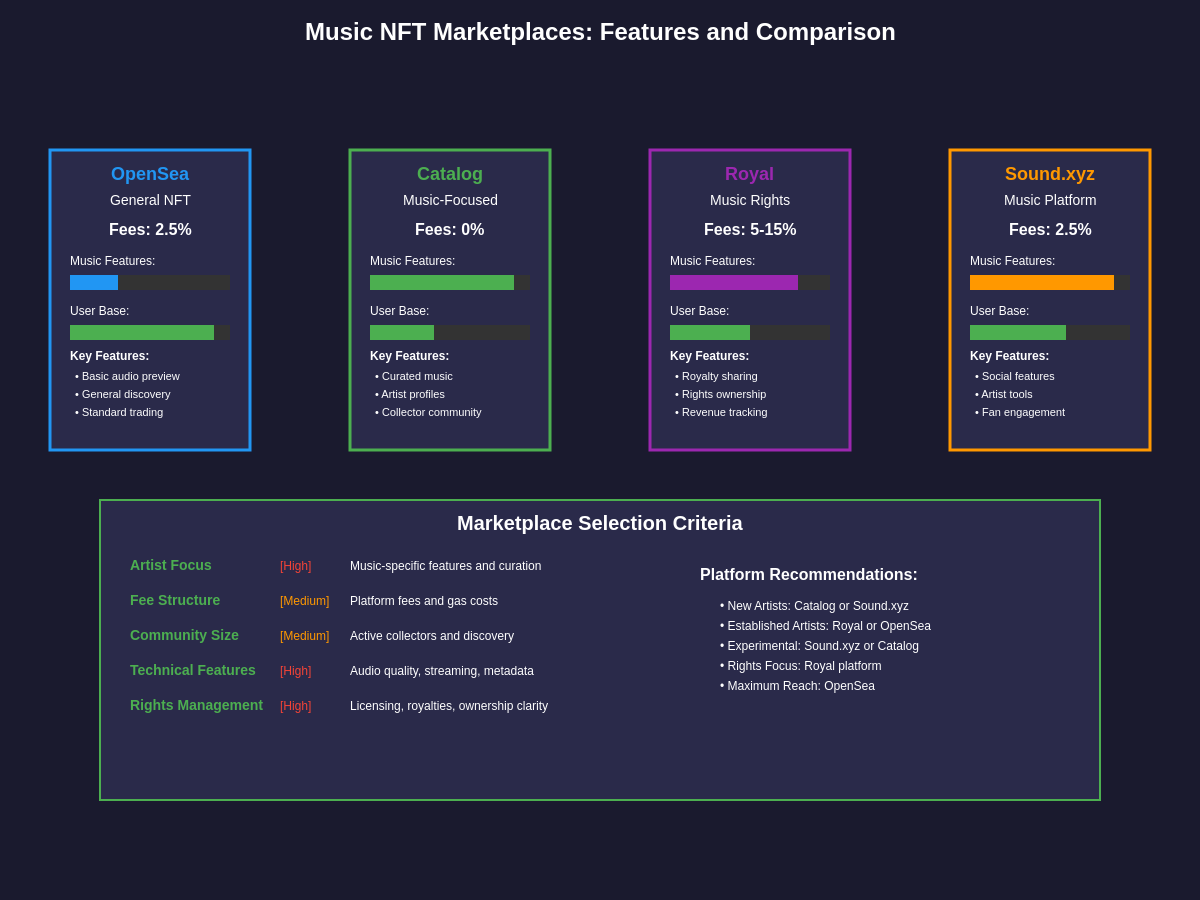
The success of music NFTs depends heavily on the development of user-friendly platforms and infrastructure that make blockchain technology accessible to both artists and music fans. Current NFT marketplaces like OpenSea, Foundation, and Catalog provide basic functionality for music NFT creation and trading, but specialized music platforms are emerging with features designed specifically for audio content, streaming integration, and music industry workflows.
Wallet technology and user experience continue to improve as developers recognize that mainstream adoption requires simplified onboarding processes for users unfamiliar with cryptocurrency and blockchain concepts. Modern wallet applications provide more intuitive interfaces, better security features, and integrated purchasing options that reduce the technical barriers to NFT participation. Some platforms offer custodial wallet services that eliminate the complexity of private key management for users who prefer simplified experiences.
Cross-chain compatibility and interoperability between different blockchain networks are becoming increasingly important as the NFT ecosystem fragments across multiple platforms and protocols. Artists want assurance that their NFTs will remain accessible and valuable regardless of which blockchain networks gain long-term adoption. Development of cross-chain bridges and multi-chain NFT standards helps ensure that music NFTs can operate across different technological infrastructures.
The integration of traditional payment methods alongside cryptocurrency options expands the potential audience for music NFTs by allowing fans to purchase digital collectibles using familiar payment systems. Platforms that accept credit cards, bank transfers, or digital payment services like PayPal make music NFTs accessible to broader audiences while still leveraging blockchain technology for ownership verification and rights management. This hybrid approach helps bridge the gap between traditional commerce and decentralized digital assets.
Legal Framework and Intellectual Property Considerations
The intersection of music NFTs with existing copyright and intellectual property law creates complex legal considerations that artists, collectors, and platforms must carefully navigate. NFT ownership typically confers rights to the specific digital token rather than comprehensive copyright ownership of the underlying musical composition or recording. Artists must clearly communicate what rights and privileges NFT ownership includes to avoid misunderstandings and potential legal disputes with collectors.
Different types of music rights, including mechanical rights, performance rights, synchronization rights, and master recording rights, may require separate consideration when creating music NFTs. Artists who own their master recordings have more flexibility in NFT creation compared to those under traditional record label contracts that assign various rights to different entities. Understanding these rights distinctions is crucial for artists who want to create legitimate and legally compliant music NFTs.
International copyright law variations create additional complexity for artists operating in global NFT marketplaces where buyers and sellers may be subject to different legal jurisdictions. Artists must consider how different countries’ copyright laws, tax regulations, and digital asset policies might affect their NFT strategies and collector relationships. Some jurisdictions have more developed regulatory frameworks for digital assets, while others remain uncertain or restrictive.
The emergence of specialized legal services focused on NFT and blockchain technology helps artists navigate these complex legal landscapes. Entertainment lawyers with expertise in both traditional music industry contracts and blockchain technology can provide guidance on NFT strategy, rights management, and regulatory compliance. As the legal framework around music NFTs continues to evolve, artists benefit from staying informed about regulatory developments and seeking appropriate legal counsel when needed.
Future Outlook and Industry Transformation
The long-term impact of music NFTs on the music industry will likely depend on their ability to solve real problems for artists while providing genuine value to music fans and collectors. Early adoption has been driven primarily by cryptocurrency enthusiasts and digital art collectors, but broader mainstream acceptance requires demonstrating clear benefits over traditional music consumption and ownership models. The technology’s success will ultimately be measured by its ability to improve artist livelihoods and enhance fan experiences.
Technological developments in blockchain scalability, user experience, and environmental sustainability will significantly influence music NFT adoption rates and long-term viability. As blockchain networks become more efficient and user-friendly, the barriers to entry for both artists and collectors will continue to decrease. Integration with existing music platforms and services will likely accelerate as the technology matures and demonstrates proven value propositions.
The potential for music NFTs to enable new forms of collaborative creation, fan participation, and revenue sharing could reshape how music is created, distributed, and consumed in the digital age. Artists might increasingly view their work as community-driven projects where fans, collectors, and collaborators share in both the creative process and financial success. This participatory model could create more sustainable and equitable music ecosystems that benefit all stakeholders.
Educational initiatives and industry support for music NFT adoption will play crucial roles in determining the technology’s long-term success. As more artists share their experiences, platforms improve their services, and the technology becomes more accessible, music NFTs may transition from experimental novelty to standard industry practice. The convergence of music NFTs with other emerging technologies like virtual reality, augmented reality, and artificial intelligence could create entirely new categories of musical experiences and monetization opportunities.
Empowering Independent Artists and Creative Freedom
Music NFTs represent perhaps the most significant opportunity for independent artists to achieve financial sustainability and creative autonomy since the advent of digital music distribution. By eliminating intermediaries and enabling direct monetization of creative work, NFTs allow artists to build careers based on direct fan support rather than dependence on record labels, streaming platforms, or traditional gatekeepers. This independence enables artists to take creative risks, explore experimental directions, and maintain authentic connections with their audiences.
The global reach of blockchain networks means that independent artists can access worldwide audiences without requiring traditional distribution partnerships or promotional support. Artists in developing countries or underrepresented communities can participate in global music markets on equal footing with established artists from major music centers. This democratization of access could lead to greater diversity and innovation in popular music as barriers to entry continue to decrease.
Creative freedom increases significantly when artists retain ownership and control over their work through NFT-based distribution models. Artists can experiment with unconventional release formats, pricing strategies, and fan engagement approaches without seeking approval from record labels or conforming to platform requirements. This freedom to innovate could lead to new forms of musical expression and business models that haven’t been possible under traditional industry constraints.
The community-building aspects of music NFTs enable artists to develop direct relationships with supporters who appreciate and invest in their creative development over time. These relationships often extend beyond simple financial transactions to include mentorship, collaboration, and mutual support within artistic communities. Artists who successfully build these communities often find that their supporters become advocates, collaborators, and sources of inspiration that enhance their creative work. Market analysts utilizing comprehensive trading platforms and market analysis tools can better understand how community engagement metrics correlate with long-term value creation in music NFT projects.
Music NFTs represent a fundamental shift toward artist empowerment and creative autonomy that could permanently alter the power dynamics within the music industry. While challenges remain around technology adoption, market volatility, and regulatory uncertainty, the potential for artists to regain control over their digital rights and build sustainable careers through direct fan relationships offers hope for a more equitable and artist-friendly music ecosystem. The success of this transformation will ultimately depend on continued technological development, broader mainstream adoption, and the music industry’s willingness to embrace decentralized models that prioritize creator rights and fan engagement over intermediary profits.
Disclaimer: This article is for educational and informational purposes only and should not be construed as financial advice. NFT investments carry significant risks, including the potential for total loss of capital. The music NFT market is highly speculative and volatile, with values subject to dramatic fluctuations based on market sentiment, technological developments, and regulatory changes. Always conduct your own research and consult with qualified financial and legal advisors before making investment decisions or creating NFT projects. The author and publisher are not responsible for any financial losses that may occur from acting on the information provided in this article.